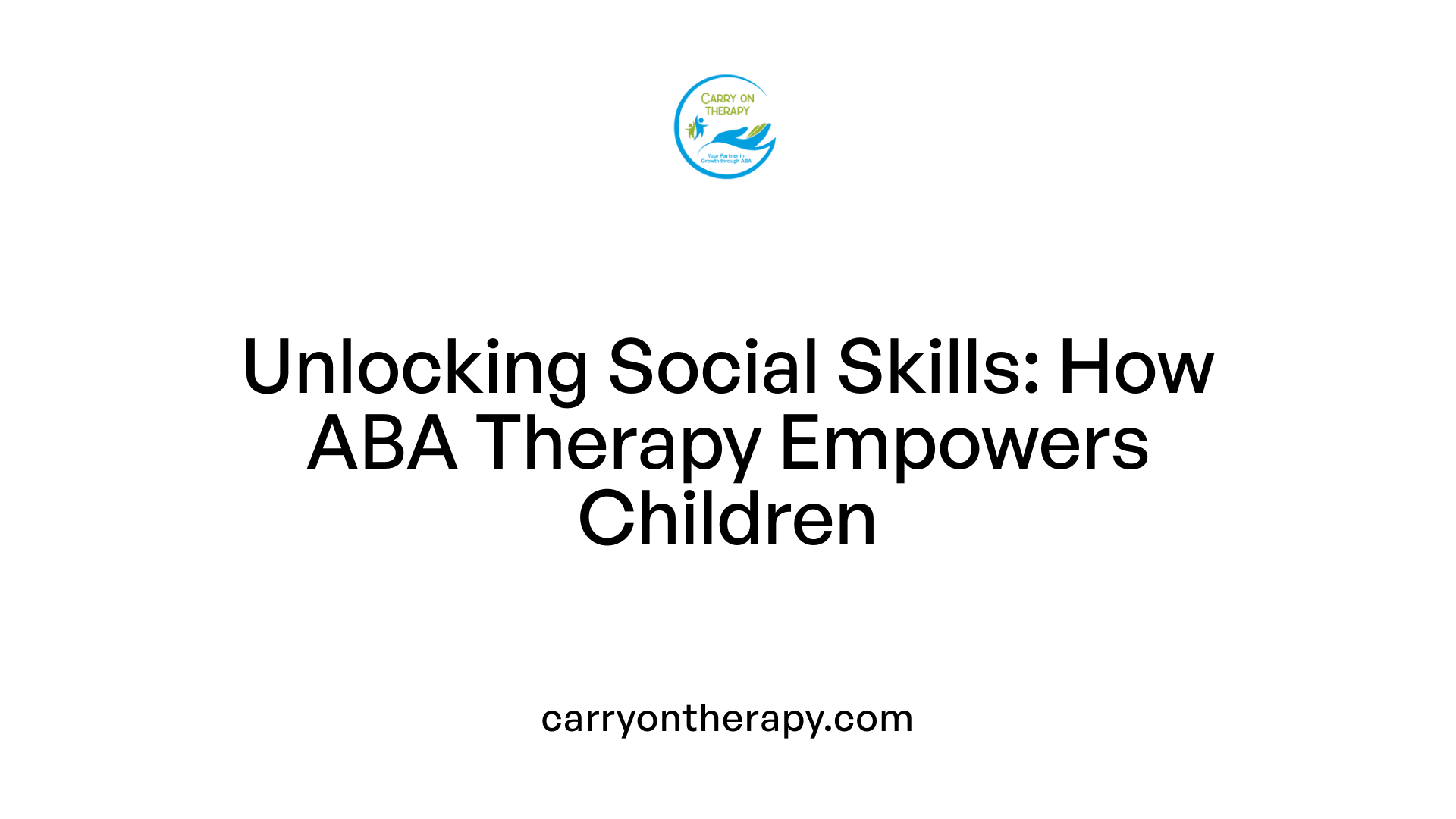The Benefits of ABA Therapy for Social Skills Development
Unlocking Social Potential: How ABA Therapy Transforms Lives

Understanding ABA Therapy
Applied Behavior Analysis (ABA) therapy stands as a scientifically grounded approach focused on improving the lives of individuals with autism by addressing behaviors and skills through environmental analysis and tailored interventions. This therapy is instrumental in fostering social skills development, communication improvement, and behavioral progress essential for everyday functioning and independence.
What Is ABA Therapy and How Does It Support Social Skills Development?

What Is Applied Behavior Analysis (ABA) Therapy?
Applied Behavior Analysis (ABA) therapy is a scientific approach focused on understanding behavior and how learning happens. It studies how behaviors are influenced by the environment and uses that knowledge to promote positive behavioral change.
How Does ABA Improve Behavior and Learning?
ABA therapy works to increase helpful behaviors while decreasing harmful or challenging behaviors. It employs techniques like positive reinforcement — rewarding desired actions to encourage their repetition. By analyzing what occurs before (antecedents) and after (consequences) a behavior, ABA modifies behaviors effectively.
What Are the Goals of ABA Therapy?
The primary goals include enhancing useful behaviors such as communication and social skills, while reducing behaviors that interfere with learning and daily functioning. ABA helps improve attention, memory, emotional regulation, and academics.
How Does ABA Target Social Skills and Communication?
ABA breaks down complex social interactions into smaller, manageable steps. Through tailored interventions like play-based therapy, role-playing, and visual aids, children learn skills such as starting conversations, interpreting social cues, and active listening. These improvements boost self-confidence and foster better relationships.
Where Is ABA Therapy Provided, and Is It Adaptable?
ABA is highly adaptable to individual needs and can be delivered in various settings—at home, in schools, or within the community. Treatments are designed and overseen by certified professionals who customize programs based on assessments to support each child's unique development journey.
Professionals Behind ABA Therapy: Expertise and Roles

Who typically provides ABA therapy and what qualifications do they have?
ABA therapy is delivered by a specialized team of professionals with distinct qualifications and roles.
Board Certified Behavior Analysts (BCBAs) are the most highly trained, usually holding a Master's degree in Psychology, Child Development, or related fields. They design assessments, develop personalized treatment plans, and oversee therapy to ensure interventions are evidence-based.
Assistant Behavior Analysts (BCaBAs) typically have a Bachelor's degree and work under the supervision of BCBAs. They assist in implementing therapy plans and help manage data collection.
Registered Behavior Technicians (RBTs) provide direct one-on-one therapy to individuals, following treatment plans created by BCBAs or BCaBAs. They collect data and use techniques like positive reinforcement during sessions.
Roles and responsibilities within ABA therapy teams
The ABA team operates collaboratively: BCBAs lead with planning and monitoring, BCaBAs support implementation and data oversight, and RBTs carry out daily therapy activities.
Importance of training and certification
All professionals undergo rigorous initial training and certification, which includes passing competency exams and supervised practical hours. They engage in ongoing education to maintain certifications, ensuring high-quality services that adapt to the latest research and individual needs.
This structured professional framework is essential for delivering effective, individualized ABA therapy that promotes meaningful behavioral improvements.
Core ABA Techniques That Enhance Social Interaction

What methods and techniques are commonly used in ABA therapy?
ABA therapy employs a variety of methods designed to promote social interaction and improve a range of skills in children with autism spectrum disorder (ASD).
Positive reinforcement plays a central role by encouraging desired behaviors through rewards, increasing the likelihood these behaviors will be repeated.
Discrete Trial Training (DTT) involves teaching skills in small, structured steps with repeated practice, ideal for mastering specific social or communication skills.
Visual aids and modeling support learning by providing clear examples of expected behaviors. This can include videos, charts, or the Picture Exchange Communication System (PECS), which helps children with limited speech communicate effectively.
Prompting and fading strategies help initiate new behaviors by providing assistance initially and then gradually reducing support to promote independence.
Behavior chaining breaks down complex social tasks into smaller, manageable steps taught sequentially, allowing children to build skills progressively.
Natural Environment Teaching (NET) encourages learning in typical settings, making skill application more meaningful and generalizable.
Finally, play-based and structured activities foster social skills like conversation initiation, interpreting social cues, and sharing by incorporating role-playing and interactive games.
Through data collection and constant assessment, ABA programs are tailored to each individual's needs, ensuring that interventions effectively enhance social interaction and communication skills.
Benefits of ABA Therapy on Communication and Emotional Regulation
How does ABA therapy improve language and communication skills?
ABA therapy plays a significant role in enhancing language and communication abilities in children with autism. By teaching children to use words effectively and understand language better, ABA employs rewards and visual aids to reinforce these skills. This structured approach enables children to communicate their needs and thoughts more clearly, fostering greater interaction.
How does ABA therapy help in developing emotional regulation and coping strategies?
Emotional regulation is essential for managing responses and behaviors. ABA uses techniques such as natural environment training and play therapy to teach children healthy coping mechanisms. These interventions enable children to better manage their emotions, reducing frustrating behaviors and promoting calmness in various settings.
What role do natural environment training and play therapy play in ABA?
Natural environment training integrates learning into everyday situations, encouraging children to practice skills in real-world contexts. Play therapy, on the other hand, provides a fun, engaging way to develop social and emotional skills through structured activities, making learning more effective and enjoyable.
How does ABA therapy impact making friends and social engagement?
ABA therapy promotes social interaction by teaching essential social skills like starting conversations, interpreting social cues, active listening, and sharing. Through group activities and social skills training, children find it easier to form friendships and engage confidently with peers.
The combined effect of improved communication and emotional regulation leads to increased self-confidence and stronger relationships for children undergoing ABA therapy.
| Aspect | Methods Used | Impact |
|---|---|---|
| Language & Communication | Rewards, visual aids | Improved use and understanding of language |
| Emotional Regulation | Natural environment training, play therapy | Better coping strategies and emotional control |
| Social Skills Development | Group activities, role-playing, social skills training | Enhanced social interaction and friendships |
| Overall Benefits | Individualized treatment plans | Boosted self-confidence and reduced problematic behaviors |
Long-Term Impact and Real-World Skills Development Through ABA

How Does ABA Therapy Support Development of Daily Living and Independence Skills?
ABA therapy goes beyond improving immediate behaviors—it plays a crucial role in helping children with autism develop essential daily living skills. These include fundamental activities such as dressing, toileting, and eating. By focusing on these areas, ABA therapy promotes independence, allowing individuals to navigate everyday life with greater confidence and autonomy. Behavioral interventions tailored to the individual ensure that these skills are learned systematically and maintained over time.
In What Ways Does ABA Prepare Individuals for Adulthood and Social Navigation?
Preparation for adulthood is a significant focus of ABA therapy. The approach teaches behavioral management and social understanding by breaking down complex social cues into manageable steps. Techniques like role-playing, social skills training, and natural environment learning help children understand social norms and effectively interact in group settings. This foundation supports smoother transitions into adult life, enabling better management of social situations and fostering positive relationships.
What Role Does ABA Play in Enhancing Intellectual Functioning and Daily Living?
Research highlights that intensive, long-term ABA therapy (25-40 hours per week for 1-3 years) can improve intellectual functioning, language abilities, and daily living skills in children with autism. Customized therapy sessions designed by board-certified behavior analysts address specific cognitive and practical challenges, leading to enhanced focus, communication, and memory. These improvements contribute to the ability to learn and function independently in various environments.
Why Is Early and Intensive ABA Therapy Important?
Starting ABA therapy early—ideally before age six—maximizes the developmental benefits due to the brain's heightened capacity for learning at a young age. Intensive, prolonged intervention ensures that skills are not only acquired but also generalized across settings and maintained long term. Early intervention leads to better outcomes in key areas such as communication, emotional regulation, and social skills, boosting lifelong success.
What Are the Potential Benefits and Limitations of ABA Therapy for Individuals with Autism?
ABA therapy offers numerous benefits, including improved communication, social skills, decreased harmful behaviors, and enhanced self-confidence. It is evidence-based, adaptable, and integrates techniques like positive reinforcement and play-based learning to engage individuals effectively. However, therapy outcomes can vary among individuals, and some may find the intensity demanding. Historically, concerns existed about aversive methods, but modern ABA largely excludes these practices. Critics also emphasize respecting neurological diversity and the autonomy of those receiving therapy. Ethically implemented, individualized ABA supports meaningful participation in society and long-term positive behavior.
| Aspect | Benefits | Considerations and Details |
|---|---|---|
| Daily Living Skills | Dressing, toileting, eating independence | Essential for real-world functioning and autonomy |
| Social Navigation | Understanding cues, managing relationships | Role-playing and group activities foster smoother social interactions |
| Intellectual and Cognitive Gains | Improved focus, memory, language | Intensive therapy improves comprehensive developmental areas |
| Early Intervention | Greatest impact on brain development | Early start (before age six) leads to better generalized outcomes |
| Therapy Intensity | Intensive hours improve results | Intensity varies; must be balanced with individual tolerance |
| Ethical Implementation | Avoidance of aversive methods | Emphasizes respect for neurodiversity and personal autonomy |
Ethical Considerations and Evolving Practices in ABA Therapy

What Are the Potential Benefits and Limitations of ABA Therapy for Individuals with Autism?
ABA therapy has demonstrated significant benefits, including improved communication, social skills, emotional regulation, and reduction of harmful behaviors. Its evidence-based framework, now enhanced with naturalistic and play-based techniques, allows for individualized treatment that respects the unique needs and preferences of each child. Such approaches foster greater engagement and skill generalization across settings, promoting independence and meaningful societal participation.
Historically, ABA faced criticism for the use of aversive techniques aimed at reducing problematic behaviors. These methods, which sometimes involved punishment, have been almost entirely abandoned in contemporary practice. Today, ethical treatment prioritizes positive reinforcement, respect, and dignity. This shift aligns with broader concerns around respecting neurodiversity—the idea that neurological differences like autism are natural variations rather than disorders to be "fixed."
Modern ABA practices emphasize individualized therapy that supports personal identity and autonomy. Techniques such as natural environment training and play therapy encourage learning through meaningful, enjoyable experiences rather than rote drills. This compassionate approach helps children develop social skills in ways that feel authentic and empowering.
Limitations remain, including varying outcomes depending on individual factors and concerns about the intensity or duration of therapy programs. Ongoing dialogue between practitioners, families, and autistic advocates continues to refine ethical standards and ensure treatments align with the best interests of those served.
In summary, ABA therapy, when provided with ethical rigor and sensitivity to neurodiversity, can offer substantial benefits. Its evolution underscores a commitment to respect, individualized care, and support for lifelong growth and wellbeing.
ABA Therapy: A Vital Tool for Social Skills and Beyond
ABA therapy continues to play a crucial role in enhancing social skills and overall functioning for children with autism by providing structured, evidence-based, and individualized interventions. Delivered by qualified professionals using scientifically validated methods, it offers tangible benefits such as improved communication, emotional regulation, and independence. Ongoing advancements and an emphasis on ethical, respectful, and naturalistic approaches ensure ABA therapy remains a progressive option to help individuals with autism navigate social complexities and lead fuller, more connected lives.
References
- Applied Behavior Analysis (ABA)
- 6 Benefits of ABA Therapy for Children with Autism
- Enhancing Social Skills Through ABA Therapy
- The Controversy Around ABA
- Concerns About ABA-Based Intervention: An Evaluation and ...
- Debunking 7 Common Myths About ABA Therapy - GSEP Blog
- Statement on Use of Applied Behavior Analysis (ABA) for ...







